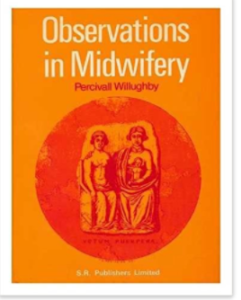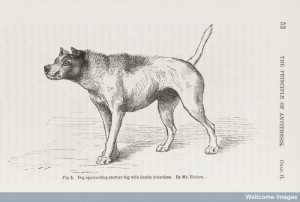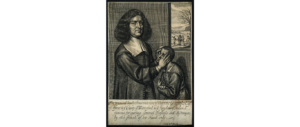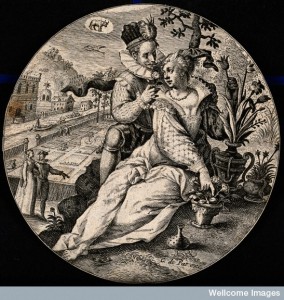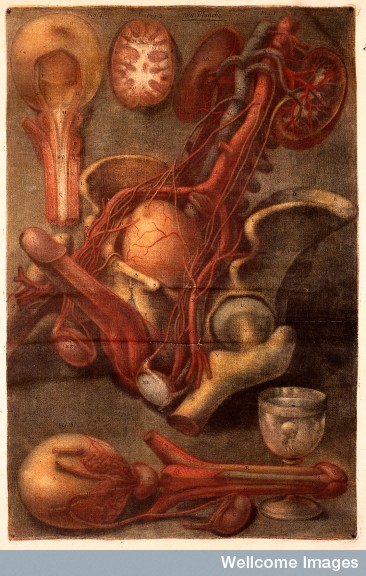
(I should probably insert a NSFW warning in here – depending on where you work)
Now as regular readers will be aware much of my research is focused on infertility and impotence. However, there were other troubling medical problems that affected the reproductive organs. One such problem was, we could think of it, the exact opposite of impotence; priapism was when the body was afflicted with a continual erection which occurred without the sensation of lust.
Some medical writers attributed this particular problem to the fullness of the artery in the penis, or to an excess of wind in the body.1 Wind in the right quantity was thought to be a cure for impotence (until the 18th century when greater anatomical knowledge of the male genitalia banished wind from this process) and men were encouraged to eat beans, peas and nuts to inflate their lacklustre organs. Indeed Jane Sharp’s Midwives Book noted that the yard (penis) could be swelled by wind ‘and therefore all windy meats, as Pulse, Beans, and Pease and the like, will make the Yard stand, and sometimes they cause a priapisme or continual standing of the Yard, which will be more troublesome than if it should never stand at all’.2
For those who found themselves so troubled, the experience could be painful and unpleasant experience. John Floyer noted the case of one man who suffered from this disorder,
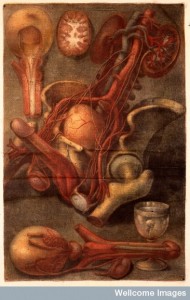
Credit: Wellcome Library, London.
‘The Person is on a middle Age, and fat habit of Body, who every Night has a Priapism in his Sleep … it never seizes him but in his Sleep at Night ,and never in the Day-time, though he sleep then. This painful Erection he imputes wholly to Windiness, and thus he describes it; I often plainly and loudly hear the Wind to make a Noise in that part, like that of the Guts, especially in the morning’.3
So how to cure such a problem? Well John Smith was careful to point out in A Compleat Practice of Physick that the condition was ‘not asswaged by Venery’, but by the less enjoyable remedies ‘hunger, vomit, [and] Chafing of the upper parts’.4
Perhaps as expected, given that several authors blamed wind for the condition, Dr Trigg’s Secrets advised men to ‘use such things as dissolve and break wind’.5 In particular he recommended a fomentation (a rag or cloth soaked in herbs and applied to the relevant body part) made of pennyroyal, oregano, caraway seeds, anise seeds, and cumin seeds boiled in water.6
The dispensatory of the Royal College of Physicians, translated by Nicholas Culpeper, suggested that Hemlock, which was believed to be cold in nature, outwardly applied to the body would help the ‘continuall standing of the Yard’, as well as easing shingles and ulcers.7
Impotence was not then the only unwanted affliction that could disrupt men body’s and their ability to engage in the ‘sports of Venus’. The pain and cramping sensation of priapism was, most likely, just as unwelcome, and required a diligent change of diet and use of a range of cooling remedies as well as those that would disperse the nuisance wind that had gathered in the body.
_______
1. Jean Feyens, A New and Needful Treatise of Spirits and Wind offending Mans Body … (London, 1668), p.49.
2. Jane Sharp, The Midwives Book … (London, 1671), pp. 30-31.
3. John Floyer, The Preternatural state of animal humours … (London, 1696), p.188.
4. John Smith, A compleat practice of physick. Wherein is plainly described, the nature, causes, differences, and signs, of all diseases in the body of man. VVith the choicest cures for the same (London, 1656), p.285.
5. William Trigg, Dr. Trigg’s Secrets, Arcana’s and Panacea’s … (London, 1665), p. 162.
6. Ibid, p. 162.
7. Royal College of Physicians, Pharmacopoeia Londinensis, or , the London Dispensatory … (London, 1653), p. 17.
© Copyright Jennifer Evans all rights reserved

